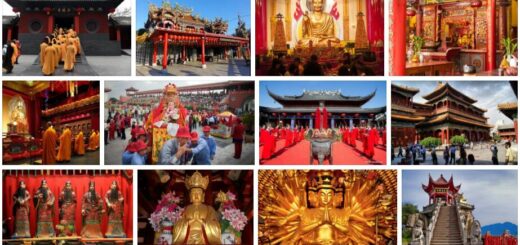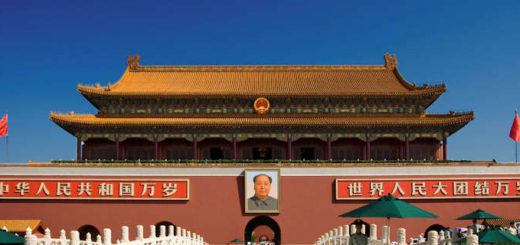World Heritages in China Part 5
Shennongjia – forest area in the Chinese province of Hubei (World Heritage)
Shennongjia is located in the province of Hubei (also Hupeh, Hupei) in central China. Two areas were designated as World Heritage in 2016: the Shennongding / Badong nature reserve in the west and the Laojunshan forests in the east. These are the most extensive virgin forests in central China. As protected areas, they play an important role in stabilizing biological diversity. Many endangered animal species have their refuge here, including primates such as the snub nose (Rhinopithecus roxellana), big cats such as the clouded leopard (Neofelis nebulosa) or the leopard (Panthera pardus), collar bears (Ursus thibetanus) and the Chinese giant salamander (Andrii).
Shennongjia was also of importance for the history of botanical science: as early as the 19th century, international research teams explored the species-rich flora there.
Shennongjia – Wooded Area in Hubei Province, China: Facts
| Official title: | Shennongjia – forest area in the Chinese province of Hubei |
| Natural monument: | Protected areas with many endangered species. These refuges were also important for the history of botanical research |
| Continent: | Asia |
| Country: | China |
| Location: | Shennongding / Badong nature reserve in the west of the province and the forests of Laojunshan in the east |
| Appointment: | 2016 |
| Meaning: | Protected areas in which the ecological diversity of the habitats is to be preserved |
Rock paintings on Mount Hua Shan and the Zuo Jiang River (World Heritage)
Southwest China is known for its karst landscape. Over the course of millions of years, erosion in the humid subtropical climate created a low mountain range in which ridges, ridges and valleys cut by rivers alternate. The numerous historical paintings on the steep rock walls of the Hua Shan are less well known. They were only discovered in the middle of the 20th century and are testimony to the extinct Dongson culture. Their meaning is still largely in the dark.
Hua Shan Mountain and Zuo Jiang River Rock Art: Facts
| Official title: | Rock paintings of the cultural landscape on Hua Shan Mountain and the Zuo Jiang River |
| Cultural monument: | Rock paintings in 38 locations along the Zuo Jiang and its tributary Ming Jiang; originated between the 5th century BC And the 2nd century AD. |
| Continent: | Asia |
| Country: | China |
| Location: | Guangxi Zhuang Autonomous Region; near the border with Vietnam |
| Appointment: | 2016 |
| Meaning: | extraordinary testimony to the extinct Dongson culture in southern China |
Dongson culture
The Dongson culture, also known as the bronze drum culture, marks the transition from the Bronze Age to the Iron Age in South Asia. The Luoyue were the bearers of the culture. They are the ancestors of today’s Zhuang, the Tai-speaking ethnic groups in the Chinese border region with Vietnam. The striking red rock paintings that they left thousands of times behind for posterity date from the 5th century BC. BC to the 2nd century AD They mostly show human figures with raised arms, the largest are over three meters, the smallest only 20 centimeters. The rock paintings, which have been awarded by UNESCO, are located in a total of 38 locations, spread over three areas that stretch between Ningming and Tuoluzhen along the winding Zuo Jiang and its tributary Ming Jiang.
Tusi sites (World Heritage)
According to computergees, in the mountainous southwest of China lie the remains of tribal areas, the chiefs of which were appointed by the Chinese central government as “Tusi”, hereditary rulers, between the 13th and 20th centuries. Fortifications and tombs of the tribal chiefs bear witness to this special system of rule in southern China.
Centuries earlier, the practice had developed in China of facilitating central rule over the huge empire by integrating ethnic minorities and their feudal systems. The Mongols, who made Beijing their seat of government in 1264 and founded the Yuan dynasty in 1271, ruled strictly hierarchically and relied on their military, but used these existing Chinese structures for administration. For the minorities this meant the opportunity to maintain their customs and lifestyle, while the immigrant conquerors benefited from a relatively smooth administration.
The “Tusi” system of hereditary regional rulers was also practiced during the Ming Dynasty (1368 to 1644) and beyond the Qing period (1644 to 1911/12).
Tusi sites: facts
| Official title: | Tusi sites |
| Cultural monument: | Remains of tribal areas with fortifications, tombs and border walls as well as archaeological finds such as official seals of local Tusi, jewelry and porcelain |
| Continent: | Asia |
| Country: | China |
| Location: | Laosicheng, Tangya and the Hailongtun Fortress in southwest China |
| Appointment: | 2015 |
| Meaning: | The world heritage site bears outstanding testimony to the specific form of rulership, as it was refined in the Yuan and Ming periods. |



